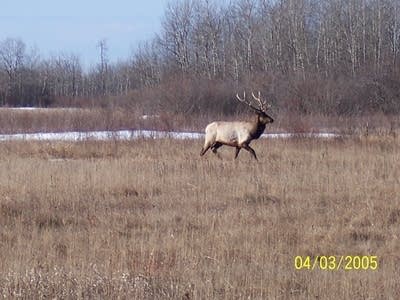Northern Minnesota elk herd flourishing
Go Deeper.
Create an account or log in to save stories.
Like this?
Thanks for liking this story! We have added it to a list of your favorite stories.

Russ Reisz is eager to show off the Kittson county elk herd, but he can't find them.
Reisz is with the Nature Conservancy, and on this windy afternoon he's on a state wildlife management area about three miles from the Canadian border, looking for elk.
It's the people in the area that will determine how large this herd gets before we have to start hunting it.
"We have a good idea where they're at. When I say a good idea, I mean maybe 10,000 acres. From where we're sitting right here, you can go north five miles and not hit a road," says Reisz. "They could be five six miles off a road and the only way you'd find them is to walk out that far and find them."
For those who might doubt the claim that a hundred or more elk roam across thousands of acres of Kittson county, Reisz offers video he shot here last fall. It shows several bull elk bugling as they claim territory for the fall breeding season.
Turn Up Your Support
MPR News helps you turn down the noise and build shared understanding. Turn up your support for this public resource and keep trusted journalism accessible to all.
Elk were native in Minnesota before European settlement when farming turned prairie and woodland into fields, and drove the elk out of the state.
In the 1930s elk were reintroduced near Grygla. Because of crop damage caused by the elk, the legislature ordered hunting to limit the size of the Grygla herd.
In the 1980s a few elk returned to Kittson county, likely from a large herd in Manitoba. In the past few years the herd has grown to around 100 animals.
This part of Minnesota is known as the tallgrass aspen parkland.

DNR Area Wildlife Manager Donovan Pietruszewski says it's likely the elk moved down from Canada as large tracts of land were put into conservation programs.
"Before European settlement this was prairie grasses, aspen groves and oak savanahs. They (elk) hung on here, that's what they evolved with and that's what we're trying to bring back. We bring that back and the elk will stay here, I think," says Pietruszewski.
While the size of the Minnesota elk herd near Grygla is limited law, there are no restrictions on the size of the Kittson county herd. Rocky Mountain Elk Foundation Regional Director Ralph Cinfio says the Kittson county herd is poised for a population explosion.
"That Kittson county herd biologically speaking has hit that point of a hundred plus animals. They call is the minimum viable population, where it should start growing exponentially at this point," says Cinfio.
So how big could the herd get? Tens of thousands of elk once roamed this part of the state.
The DNR's Donovan Pietruszewski says there have already been some conflicts with area farmers who's crops have been damaged by elk. But in this part of the state many farmers raise cattle, so there's less chance of crop damage.

He says his goal is to manage the herd at a size people will accept.
"It's the people in the area that will determine how large this herd gets before we have to start hunting it," says Pietruszewski. "We've got plenty of habitat between us and Manitoba. It could probably support several thousand elk. We'll probably never see that, but we'll probably never see that but we'll probably see several hundred at some point in time."
There's no hunting for the Kittson county elk herd, but Pietruszewski says that might change in the next couple of years. He says hunting will help reduce crop damage and slow the growth of the herd.
Pietruszewski says a few hard winters, or disease could also limit the growth of the elk herd. Minnesota elk that have been killed in previous hunts near Grygla were infested with liver flukes, thought to be one of the factors that caused a precipitous decline in the northwestern Minnesota moose population. But experts say the elk seem unaffected.

Another threat could be anthrax, which occurs naturally in northwestern Minnesota and has killed cattle in recent years.
But Elk Foundation Regional Director Ralph Cinfio says the biggest threat to the elk herd is changing land use in the area. He says farms and ranches are being sold as recreational land.
"They're being sold and subdivided into 40 acre parcels, and people are putting cabins on them. And when you do that you lose these huge contiguous pieces of land. And that is so important to an ecosystem," says Cinfio. "This is unique to North America. It extends into Canada. It's important to keep that intact."
Cinfio is hoping locals will embrace the elk herd. He says across the country, wild elk are a tourism draw. He points to the success of eco-tourism built around elk herds in Pennsylvania and Kentucky. Cinfio thinks as the Kittson county herd grows larger, the fall mating ritual could draw thousands of visitors to the area.





